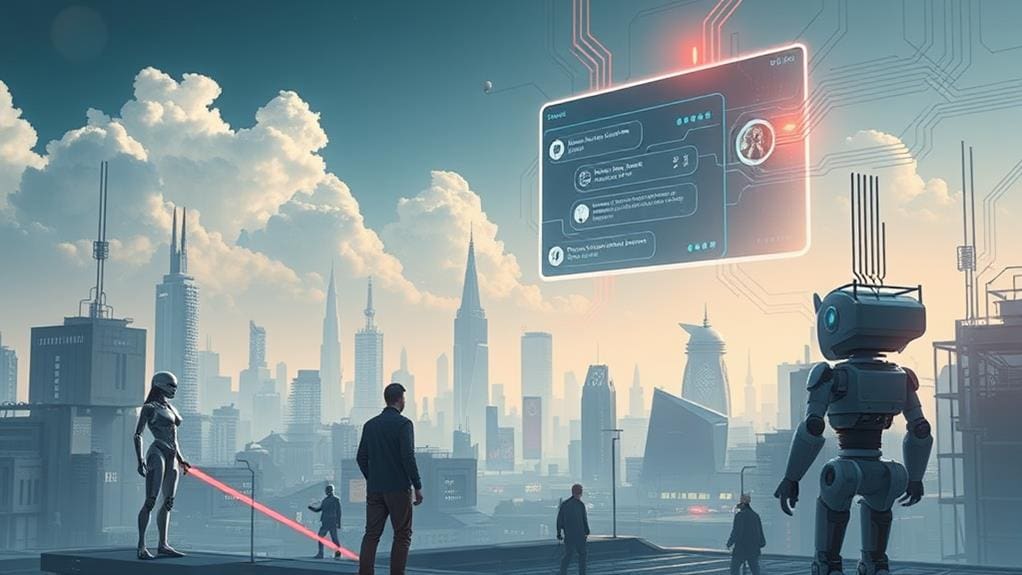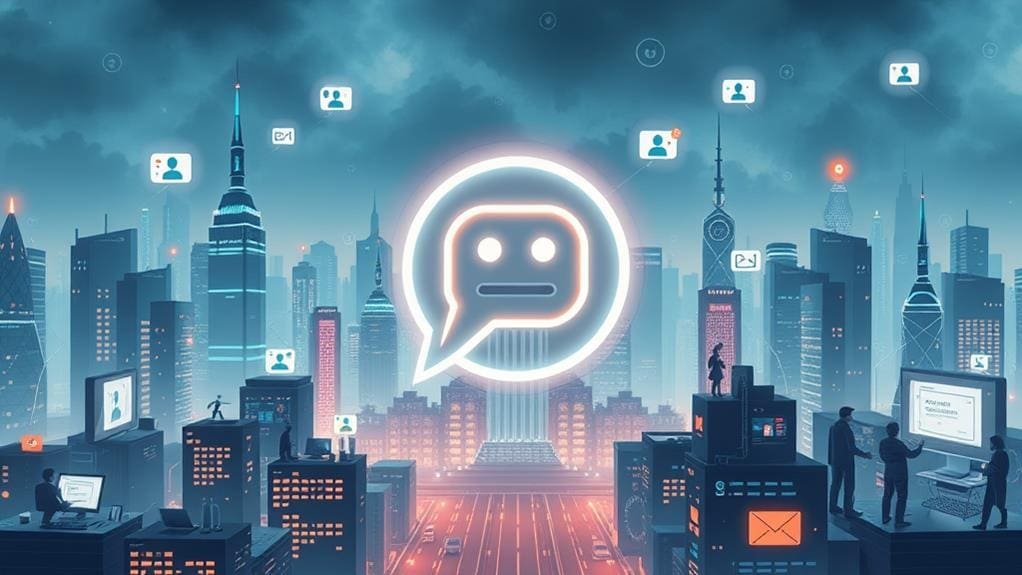You may not be aware that you've likely interacted with a chatbot, even if you don't remember it – many businesses have quietly integrated these automated systems into their websites and customer support services. As a result, you're probably experiencing more efficient customer service, but have you ever wondered what exactly chatbots can do? They're used across various industries to improve user experience and streamline operations, but how exactly do they do that, and what other capabilities do they possess? To better understand their impact, it's worth taking a closer look at the different uses and benefits of chatbots.
Key Takeaways
- Chatbots handle customer inquiries and provide support in various industries, improving user experience and satisfaction.
- They are used in e-commerce for product recommendations, order tracking, and transactions, enhancing the overall customer experience.
- In the healthcare industry, chatbots offer medical information, schedule appointments, and provide patient support.
- Chatbots provide learning resources and support to students, offering answers to queries in educational institutions.
- Chatbots also automate workflows and free up employees to focus on more complex tasks in multiple business sectors.
Common Chatbot Uses
Utilized in various industries, chatbots are streamlining operations, improving customer satisfaction, and enhancing user experience.
In customer service, you'll often find chatbots handling frequent inquiries, freeing up human agents to focus on complex issues. This provides 24/7 support to customers, making them a valuable asset for businesses.
Chatbots are also used in e-commerce to offer product recommendations, assist with order tracking, and facilitate transactions and payments. As a result, businesses can reduce costs by minimizing the need for human intervention, and also enhance customer experience by providing instant responses to queries.
In the healthcare industry, chatbots provide medical information, schedule appointments, and offer patient support, improving the overall patient experience.
You'll also find chatbots in education, offering student support, answering queries, and providing learning resources.
In finance, chatbots provide account information, transaction history, and investment advice, streamlining customer interactions.
Chatbots can be used to automate website support, assist with site navigation, and track orders and inventory.
How Chatbots Work
Chatbots operate by utilizing natural language processing (NLP) to comprehend and analyze user inputs, and then responding accordingly based on predefined rules, machine learning algorithms, or a combination of both.
You'll notice that chatbots function differently depending on their type. For instance, older chatbots relied on scripts, whereas modern ones utilize AI and ML to provide more flexible conversations.
This flexibility in conversation is made possible by natural language processing, which enables chatbots to understand and interpret user input like human conversation. Additionally, machine learning algorithms can be used to train chatbots on vast datasets of conversational data, allowing them to learn from interactions and improve responses over time.
- You'll see three key components that power chatbots: NLP to process human language, ML algorithms to learn from datasets, and a rule-based system to guide interactions.
- Chatbots can be either stateless or stateful – stateless ones treat each conversation as new, while stateful ones review past interactions for context.
- AI and ML integration enables chatbots to learn from interactions, improving responses over time and providing more accurate and personalized support.
- Chatbot software allows businesses to create and deploy chatbots, increasing support capacity and offering 24/7 support.
- Generative AI technology allows chatbots to sound more human-like, detecting customer intent and providing agents with necessary context to offer better service
Benefits of Chatbots
Implementing chatbots can substantially enhance your business operations, bringing numerous benefits that can positively impact your bottom line.
By automating routine customer activities, chatbots can help you improve customer experience and reduce the need for human interaction. This can lead to increased customer satisfaction and loyalty, as well as cost savings for your business.
Chatbots can also boost operational efficiency by automating workflows and freeing up employees to focus on more complex tasks.
Effective chatbot development requires understanding the target audience, which involves creating user personas to gain a deeper understanding of the target audience's behavior, motivations, and goals chatbot development.
By identifying the functional scope of the chatbot and defining primary and secondary functions, businesses can guarantee their chatbot meets its intended purpose and provides value to users.
With chatbots, you can scale your customer support operations without hiring new agents, providing 24/7 support to your customers.
This can lead to increased sales and revenue, as well as improved customer engagement.
Chatbots can also help you personalize your customer interactions, providing tailored recommendations and offers to each customer.
By automating routine customer support tasks, chatbots can help you reduce costs and improve operational efficiency, allowing you to allocate resources more effectively.
Creating a Chatbot
Creating a chatbot starts with identifying its purpose and goals, which will determine the type of interactions it will have with users and inform the choice of platform or framework to build on, such as Dialogflow or ManyChat.
To develop a chatbot, you'll need to design the conversation flow and user interface, guaranteeing a user-friendly experience and clear understanding of the chatbot's capabilities.
Effective mobile app development involves creating software applications specifically designed to run on mobile devices, which is essential for chatbot development as many users will interact with the chatbot through their mobile devices.
A well-designed user interface can also consider factors like simplicity, consistency, and intuitiveness to create a cohesive and visually appealing experience.
You'll also need to develop the chatbot's language understanding and response generation capabilities using natural language processing (NLP) and machine learning (ML).
This will enable your chatbot to effectively interact with users and provide personalized conversations, taking customer experience to the next level.
Some key considerations when creating a chatbot include:
- *Defining the chatbot's purpose and goals* to determine the type of interactions it will have with users
- *Designing a user-friendly conversation flow and interface* to guarantee a clear understanding of the chatbot's capabilities
- *Developing NLP and ML capabilities* to enable effective user interactions
- *Testing and refining the chatbot* to guarantee it meets desired goals and user expectations
- *Utilizing chatbot software and resources* to streamline the development process and offer 24/7 support
The Future of Chatbots

As businesses continue to harness the power of artificial intelligence, you can expect a significant shift in how customer interactions unfold, with 80% of businesses projected to use chatbots by 2024, according to Gartner.
This integration of chatbots into customer experience will revolutionize the way you interact with customers, providing 24/7 support and increasing support capacity without requiring additional human agents.
Approximately 54% of all employees will require significant reskilling to keep up with AI technologies.
By utilizing chatbots to automate tasks and optimize processes, companies can increase efficiency and allow their workforce to focus on higher-level tasks that add value.
The future of chatbots lies in their ability to learn from human interactions and adapt to new situations, making them increasingly sophisticated and effective in providing customer support and services.
With the help of generative AI and natural language processing (NLP), chatbots will become even more conversational and human-like, enabling them to detect customer intent and provide agents with necessary customer context to offer better service.
As a result, you can expect a significant reduction in customer support costs and improvement in customer experience.
The combination of AI and 5G technology will also bring enhanced chatbot features, such as faster recommendations and predictions, and high-definition video conferencing accessible from within conversations.
Frequently Asked Questions
What Is the Purpose of Chatbots?
You're about to access the secret to automating customer support. The purpose of chatbots is to simulate human-like conversations, using NLP and ML to understand and respond to user inputs, freeing up human agents for complex issues.
What Are People Using Chatbot For?
You're using chatbots to access product info, track orders, and get support 24/7, as well as for ecommerce, education, healthcare, and finance tasks, like appointment scheduling, transaction tracking, and personalized recommendations.
What Is an Example of a Chatbot?
You're about to access a world of conversational AI. An example of a chatbot is a virtual assistant like Siri, Alexa, or Google Assistant, using NLP and ML to understand and respond to user voice commands.
Who Uses Chatbots the Most?
You'll find that 60% of millennials use chatbots the most, as they're more likely to interact with a chatbot than any other age group, driving the widespread adoption of chatbot technology across various sectors.
Conclusion
You've made it to the end of this chatbot primer, congratulations. Now you're probably thinking, "I can finally replace all my human friends with chatbots." Not quite. While chatbots are incredibly useful for automating tasks and providing 24/7 support, they still can't replace human empathy and complex problem-solving. So, go ahead and create your own chatbot, but don't expect it to attend your birthday party or offer a shoulder to cry on.

